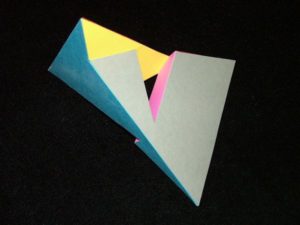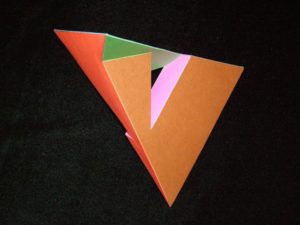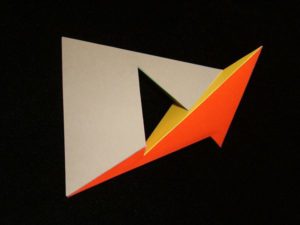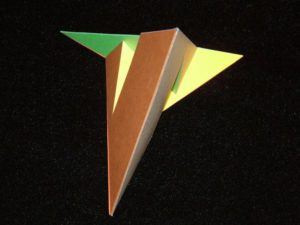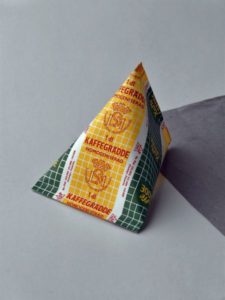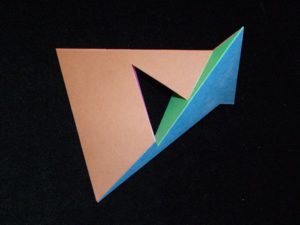It won’t come as any surprise to learn that there are many other polyhedral shapes, models, configurations etc that we haven’t featured along the way, yet are full of interest in themselves. Among these are Deltahedra, puzzles, curiosities… Buckyballs, chains of tetrahedra… there’s plenty to say here.
And then we might indulge in a discussion of the various mathematical toys and games which play into this space…like Geomag…Tensegrity…Early Learning Centre…And then we still need a discussion of the literature, and of the websites…and what about the marvellous world of 3D printing? Oh panic…!For the moment we’ll look at just three models which didn’t get onto the earlier pages: the Concave Pyritohedral Dodecahedron, the Compound of 3 Disphenoids, and the Szilassi Polyhedron.
Concave Pyritohedral Dodecahedron
At first sight this looks just like a weird spiky thing – and given that we’ve already created lots of these it seems like nothing special – but this one has a number of nice features.
For a start, it has twelve faces, all the same – so it’s a dodecahedron, though not a regular one. The faces are also pentagons, though not regular ones: and it’s also clearly concave.
So far, so good: but the faces are actually derived from the diagonals of regular pentagons – and who would have thought these could be made to fit together in a shape like this? Perhaps, though, the point is more obvious than you might think. After all, a regular dodecahedron can be derived by building caps onto a cube…and if we recall cubes can tessellate the whole of space, it might be natural to ask what the cap removes from the next cube along. The answer, if you stack dodecahedrons correctly, is this one: indeed you can see the points of the cube very clearly, and in fact the whole thing looks rather like a cube that’s been ‘sucked inwards’. You fill the whole of space by alternating regular Dodecahedrons with Concave Pyritohedral Dodecahedrons…which is a discovery I’d put alongside the realisation that you can also fill space with Cuboctahedrons and Octahedrons.
The last point to note is the ‘pyritohedral’ one, which recalls the Iron Pyrites connection with the Dodecahedron. For the moment I won’t go deeply into this but I’ll point to the animation in the Wikipedia page on the Pyritohedron, which shows it all in a lovely animation. The idea is that if you regard the cube corners as fixed but let the points half-way along the edges go in and out, you can essentially get all kinds of Dodecahedrons including the regular one, the squashed one characteristic of Iron Pyrites, and even this one. Because of the mineral connection the whole collection of them now get labelled as Pyritohedral, or as Pyritohedrons. Strictly there’s no need for this – after all, they’re all really just Dodecahedrons – but I suspect the attraction of the word ‘Pirates’ is too hard to resist.
Compound of Three Disphenoids
‘Disphenoid’ is simply a name for a distorted (or non-Regular) Tetrahedron, commonly found as a carton contianing milk or juice. Here, though, three are put together using the mid-edge parts of a truncated tetrahedron to make… well, what looks like another slightly scary emblem of a world-domination sect…
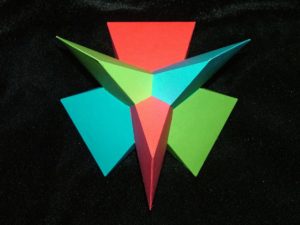
Szilassi Polyhedron
Last of the three models here is the Szilassi Polyhedron. The challenge here derives from the 4-colour theorem, or rather the 7-colour theorem which applies to a surface with a hole in it (e.g. a doughnut, a bagel, a cup, etc.)
It’s rather fun to cover a doughnut with 7 colours of icing, but it’s harder to construct a shape with 7 flat faces where every face touches each of the other 6. The Szilassi polyhedron does exactly this, in a rather spectacular form. It’s also, by the way, a horrible thing to build.
And what next? Well, it’s time to look at where to go for more of this… Polyhedron Resources.


